Kann eine einfache Designänderung eine Revolution in der Produktivität auslösen? Der Schlüssel dazu könnte in der Single Minute Exchange of Die (SMED) Ansatz. Diese Methode geht über die bloße Verkürzung der Umrüstzeiten hinaus. Sie formt den Kern der Produktionseffizienz neu. In der harten Arena der Fertigung, wo Ausfallzeiten einen großen Teil des Zeitplans ausmachen, ist der Einsatz von SMED während der Entwicklung von entscheidender Bedeutung.
Bei guter Umsetzung kann SMED die Umrüstzeiten drastisch verkürzen, um 50% bis zu mehr als 90%. Stellen Sie sich vor, ein führender Automobilhersteller reduziert den Werkzeugwechsel von 8 Stunden auf nur 15 Minuten. Das ist die Auswirkung einer auf SMED ausgerichteten Konstruktion. Diese Verbesserungen steigern die Effizienz und unterstützen eine Kultur des kontinuierlichen Fortschritts, die den Erfolg steigert.
Die wichtigsten Erkenntnisse
- Die Integration von SMED-Prinzipien kann die Umrüstzeiten drastisch verkürzen und die Gesamtanlageneffektivität um 15-25% erhöhen.
- SMED system implementation supports smaller batches and just-in-time operations, reducing inventory costs.
- Eine auf SMED ausgerichtete Planung gewährleistet eine langfristige Betriebseffizienz und reduziert den Bedarf an kostspieligen zukünftigen Änderungen.
- Die Standardisierung der Umstellungsprozesse von der ersten Entwurfsphase an fördert eine vorhersehbare und konsistente Produktionsplanung.
- Der Einsatz von modularen Anlagen und Schnellverbindungssystemen kann die Arbeitsabläufe in der Fertigung erheblich rationalisieren.
Was ist SMED in der Fertigung?
Das SMED-System (Single-Minute Exchange of Die) wurde von Shigeo Shingo entwickelt. Es verkürzt die Rüstzeiten für die Ausrüstung auf unter 10 Minuten. Diese Veränderung hat eine Revolution in der Arbeitsweise von Fabriken ausgelöst. Durch die Umstellung von internen auf externe Aufgaben werden die Rüstvorgänge schneller und effizienter. Der SMED-Prozess konzentriert sich darauf, sich vorzubereiten, Aufgaben aufzuteilen, Dinge zu standardisieren und immer besser zu werden. Dies kann die Umrüstzeiten um bis zu 94% verkürzen und die Arbeitsweise der Industrie verändern.
Einführung in SMED
SMED steht für Austausch von Würfeln in einer Minuteeine neue Methode zur Verringerung der Ausfallzeiten bei der Herstellung von Produkten. Es wurde von Shigeo Shingo, einem berühmten japanischen Ingenieur, entwickelt und verkürzt die Rüstzeiten erheblich. So kann zum Beispiel eine Aufgabe, die bisher 90 Minuten dauerte, in weniger als 5 Minuten erledigt werden. Das Hauptziel von SMED besteht darin, die Rüstvorgänge extern statt intern durchzuführen. So können die Arbeiten bei laufenden Maschinen durchgeführt werden. Durch die schnellere Durchführung von Änderungen können die Fabriken schneller auf Kundenwünsche eingehen und weniger Lagerbestände halten.
Schlüsselkomponenten von SMED
Um SMED wirklich zu verstehen, muss man seine Hauptbestandteile kennen. Der erste Teil besteht darin, sich vorzubereiten, indem man die Werkzeuge und Materialien im Voraus organisiert. Dieser Schritt und Dinge wie zusätzliche Vorrichtungen und modulare Ausrüstungen sorgen für reibungslose und schnelle Umstellungen. Im zweiten Teil geht es um die Unterscheidung zwischen internen und externen Aufgaben. Bei internen Aufgaben wird die Maschine angehalten, bei externen hingegen nicht. Wenn mehr Aufgaben extern erledigt werden, verkürzen sich die Umrüstzeiten erheblich. Was zum Beispiel 90 Minuten dauerte, kann nun in weniger als 10 Minuten erledigt werden. Das steigert die Effizienz enorm.
Die Standardisierung ist der dritte wichtige Bestandteil von SMED. Sie unterteilt Aufgaben in kleine, wiederholbare Schritte. Eine Umstellung kann 30 bis 50 Schritte umfassen, an denen sowohl Menschen als auch Maschinen beteiligt sind. Wenn man Dinge standardisiert, werden Unterschiede reduziert. Dadurch bleiben die Abläufe konsistent. Außerdem wird das System durch einen Kreislauf der kontinuierlichen Verbesserung mit Hilfe von Feedback und Schulungen auf dem neuesten Stand gehalten. Auf diese Weise funktionieren die Abläufe im Laufe der Zeit immer besser.
Der intelligente Ansatz von SMED verändert die Arbeitsweise einer Produktionseinheit zum Positiven. Die Konzentration auf Maschinen, deren Umrüstung nur wenig Zeit in Anspruch nimmt, und auf Mitarbeiter, die diese Maschinen kennen, führt zu einem erfolgreichen Einsatz von SMED. Fabriken, die durch Umrüstungen mehr als 20% Zeit verlieren, sind perfekt für SMED geeignet. Durch den Einsatz von SMED erhöhen die Unternehmen ihre Kapazität, können kleinere Chargen herstellen und die Produktqualität verbessern. Dies zeigt, wie wichtig diese bahnbrechende Idee ist.
Vorteile von SMED
SMED (Single-Minute Exchange of Dies) bietet große Vorteile für die Herstellung von Produkten. Ziel ist es, die Umrüstzeiten auf unter zehn Minuten zu senken. Dies führt zu einer höheren Produktion. Branchen wie die Medizin- und Pharmabranche sowie die Etikettenindustrie profitieren stark davon.
Reduzierte Ausfallzeiten
Ein großes Plus von SMED ist der enorme Rückgang der Ausfallzeiten. Durch die Verkürzung der Rüstzeiten können die Fabriken mehr produzieren und die Maschinen besser nutzen. Interne Aufgaben werden durch externe ersetzt. Dadurch werden die Rüstvorgänge beschleunigt. So konnte beispielsweise die Umrüstzeit einer Boxenmannschaft von 67 Sekunden im Jahr 1950 auf deutlich weniger im Jahr 2013 gesenkt werden.
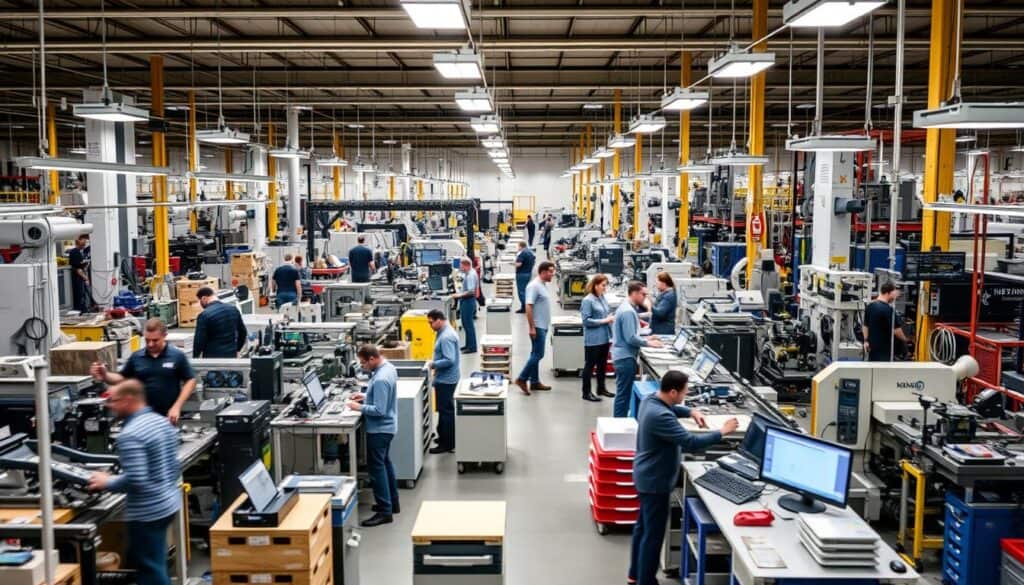
Erhöhte Flexibilität
SMED macht auch die Fertigung flexibler. Die Fabriken können ihre Zeitpläne schneller ändern, um den Kundenwünschen gerecht zu werden. Dies ist für Lohnverarbeiter sehr hilfreich. Sie können häufiger umrüsten, was bedeutet, dass sie von vielen Produkten kleinere Chargen herstellen können.
Kosteneinsparungen
Mit SMED lässt sich in der Fertigung viel Geld sparen. Es bedeutet weniger Maschinenstillstand, was die Kosten senkt und mehr Raum für die Herstellung von Produkten schafft. Außerdem spart man Geld, wenn man weniger Material auf Lager hat und weniger Materialien verwendet. Stellen Sie sich vor, Sie könnten bei jedem Teil $0,50 einsparen, nur weil Sie effizienter arbeiten.
Verbesserte Qualität
SMED bedeutet auch bessere Produkte mit weniger Fehlern. Es macht jeden Schritt der Herstellung von etwas jedes Mal gleich. Das ist besonders wichtig für die Herstellung von Dingen, die perfekt sein müssen, wie im medizinischen Bereich. Wenn man aufschreibt, wie alles gemacht wird, kann man die Qualität hoch halten.
Gesteigerte Mitarbeitermoral
Und schließlich trägt SMED dazu bei, dass sich die Arbeitnehmer bei ihrer Arbeit wohler fühlen. Wenn die Arbeit reibungsloser und weniger stressig ist, sind alle zufriedener. Wenn die Arbeitsschritte schriftlich festgehalten werden, ist es einfacher, die Arbeit gut zu erledigen. Dies führt dazu, dass die gesamte Fabrik besser arbeitet.
| Nutzen | Beschreibung |
|---|---|
| Reduzierte Ausfallzeiten | Minimiert die Rüstzeit und erhöht die Maschinenauslastung und Produktivität. |
| Erhöhte Flexibilität | Ermöglicht häufiges Umrüsten und unterstützt einen abwechslungsreichen Produktionsplan. |
| Kosteneinsparungen | Senkung der Produktionskosten durch Reduzierung von Ausfallzeiten, Lagerbeständen und Materialverschwendung. |
| Verbesserte Qualität | Verbessert die Produktqualität durch Prozessstandardisierung und Fehlerreduzierung. |
| Gesteigerte Mitarbeitermoral | Schafft ein weniger stressiges Arbeitsumfeld durch effiziente, dokumentierte Verfahren. |
Warum SMED in der Planungsphase in Betracht gezogen werden sollte
Die frühzeitige Anwendung von SMED-Grundsätzen in der Produktion bringt große Vorteile mit sich. Unternehmen wie Toyota zeigen, dass Design für SMED-Fertigung verkürzt die Umrüstzeiten radikal. Dies erhöht die Produktionseffizienz und spart Kosten.
Langfristige Effizienz
Die frühzeitige Einführung von SMED führt zu enormen Effizienzsteigerungen. Toyota verkürzte die Umrüstzeiten der Druckmaschinen von über zehn Stunden auf unter zehn Minuten. Dies ist der Neugestaltung von Prozessen und Anlagen zu verdanken. Diese Maßnahmen verkürzten die Rüstzeiten und sorgten für einen reibungslosen Produktionsablauf.
Kostenreduzierung
Die Planung mit SMED senkt die Kosten durch die Reduzierung von Leerlaufzeiten und Arbeitsaufwand. Eine neue Großverpackungsanlage benötigte weniger Umrüstzeiten und nur zwei Personen für den Betrieb. Dies zeigt die Kosten- und Effizienzgewinne durch intelligente Reduzierung der Rüstzeit und besser Produktionseffizienz.
Operative Exzellenz
SMED ist der Schlüssel für kontinuierliche operationelle Exzellenz. Sie nutzt die Vorarbeiten, die Optimierung der Ausrüstung und die Standardisierung, um Änderungen zu beschleunigen. Diese Schritte erhöhen die Konsistenz und Qualität und senken die Herstellungs- und Lagerkosten. Für Lean/Six Sigma-Anhänger ist SMED entscheidend für höchste betriebliche Effizienz.
Design für SMED-Fertigung
Design für die SMED-Fertigung bedeutet, dass bei der Planung die wichtigsten SMED-Schritte berücksichtigt werden, um bessere Ergebnisse zu erzielen. Diese Methode konzentriert sich auf...
Sie haben 33% des Artikels gelesen. Der Rest ist für unsere Community. Sie sind bereits Mitglied? Einloggen
(und auch um unsere Originalinhalte vor Scraping-Bots zu schützen)
Innovation.world Gemeinschaft
Anmelden oder Registrieren (100% kostenlos)
Lesen Sie den Rest dieses Artikels und alle Inhalte und Tools, die nur für Mitglieder zugänglich sind.
Nur echte Ingenieure, Hersteller, Designer und Marketingfachleute.
Kein Bot, kein Hater, kein Spammer.
Häufig gestellte Fragen
Was ist SMED in der Fertigung?
SMED steht für Single Minute Exchange of Die. Es ist eine Methode, die darauf abzielt, die Rüstzeiten auf unter 10 Minuten zu reduzieren. Der Ansatz umfasst die Vorbereitung, die Aufteilung der Aufgaben in solche, die bei laufender und solche, die außerhalb der Maschine erledigt werden, die Standardisierung der Arbeit und die ständige Verbesserung.
Was sind die Schlüsselkomponenten von SMED?
SMED konzentriert sich auf wichtige Schritte wie die Vorbereitung und die Unterteilung der Aufgaben in interne und externe Aufgaben. Das bedeutet, dass herausgefunden werden muss, was bei laufenden Maschinen erledigt werden kann und was nicht. Dies führt zu effizienteren Abläufen.
Was sind die wichtigsten Vorteile von SMED?
Der Einsatz von SMED verkürzt die Ausfallzeiten drastisch. Die Fabriken können schnell zwischen Produkten wechseln, was Geld spart und die Qualität verbessert. Außerdem wird die Arbeit weniger stressig, was die Zufriedenheit der Mitarbeiter erhöht.
Warum sollte SMED in der Entwurfsphase berücksichtigt werden?
Die frühzeitige Einbeziehung von SMED in die Planung bedeutet langfristig große Einsparungen und einen reibungsloseren Betrieb. So wird sichergestellt, dass die Anlagen und Prozesse von Anfang an für schnelle Änderungen vorbereitet sind.
Wie können SMED-Prinzipien in die Gestaltung integriert werden?
SMED-gerechtes Design bedeutet, dass Einrichtungsaufgaben voneinander getrennt und Verfahren standardisiert werden. Der Einsatz von Technologien wie modularer Ausrüstung und Automatisierung ermöglicht schnelle Änderungen.
Welche Strategien sind für die Umsetzung von SMED wirksam?
Zu guten SMED-Strategien gehört, dass das Management mitzieht, Teams aus verschiedenen Bereichen eingesetzt werden, Ideen in kleinen Tests ausprobiert werden und alle Beteiligten unterrichtet werden.
Was sind einige Tipps für die Gestaltung von SMED?
Zu den wichtigen Tipps gehören die Standardisierung der Arbeit, der Einsatz vielseitiger Geräte, die Minimierung von Aufgaben bei stillstehenden Maschinen und der Einsatz von Technologie für eine schnellere Einrichtung. Auch die Förderung von Teamarbeit und kontinuierlichem Feedback ist wichtig.
Wie ergänzen sich Lean Manufacturing und SMED?
Schlanke Produktion und SMED zielen beide darauf ab, die Verschwendung zu reduzieren und die Abläufe reibungsloser zu gestalten. SMED tut dies, indem es sich darauf konzentriert, die Zeit zu reduzieren, die durch das Wechseln von Geräten verloren geht. Zusammen machen sie Fabriken flexibler und effizienter.
Welche Rolle spielt die kontinuierliche Verbesserung im SMED?
Kontinuierliche Verbesserung ist entscheidend. Es geht darum, immer Wege zu finden, um die Dinge im SMED besser zu machen. Das bedeutet, dass wir regelmäßig Kontrollen durchführen und auf Feedback hören, um selbst kleine Verbesserungen bei den Rüstzeiten zu erzielen.
Können Sie Beispiele für die erfolgreiche Umsetzung von SMED nennen?
Viele Branchen wie die Automobil-, Elektronik- und Konsumgüterindustrie haben große Vorteile aus SMED gezogen. Sie haben die Zeit für den Wechsel von Aufgaben verkürzt und ihre Fähigkeit, die Nachfrage zu befriedigen, verbessert.
Was sind die häufigsten Herausforderungen bei der Umsetzung von SMED?
Einige Herausforderungen sind Mitarbeiter, die sich nicht verändern wollen, und nicht genügend Schulungsressourcen. Die Überwindung dieser Probleme erfordert gute Änderungsmanagement und dafür sorgen, dass genügend Unterstützung zur Verfügung steht.
Glossar der verwendeten Begriffe
Computer Numerically Controlled (CNC): Ein Herstellungsprozess, bei dem programmierte Computersoftware zur Steuerung von Werkzeugmaschinen verwendet wird, um einen präzisen und automatisierten Betrieb für Aufgaben wie Schneiden, Fräsen, Bohren und Gravieren von Materialien zu ermöglichen.
Network-attached storage (NAS): Ein an ein Netzwerk angeschlossenes Speichergerät, das den Datenzugriff und die gemeinsame Nutzung zwischen mehreren Benutzern und Geräten ermöglicht und in der Regel zentrale Dateispeicher-, Sicherungs- und Verwaltungsfunktionen bietet. Es arbeitet unabhängig von einem Computer und ist über Standardnetzwerkprotokolle zugänglich.
Overall Equipment Effectiveness (OEE): Eine Kennzahl zur Bewertung der Effizienz von Fertigungsprozessen, die durch Multiplikation von Verfügbarkeit, Leistung und Qualitätsraten berechnet wird. Sie identifiziert Verluste und ermöglicht so Verbesserungen der Produktivität und der betrieblichen Effizienz.
Single Minute Exchange of Dies (SMED): Eine schlanke Fertigungstechnik, die darauf abzielt, die Rüstzeiten der Geräte auf weniger als zehn Minuten zu reduzieren, schnellere Übergänge zwischen Produktionsläufen zu ermöglichen und die Gesamteffizienz durch Rationalisierung der Prozesse und Minimierung der Ausfallzeiten zu steigern.
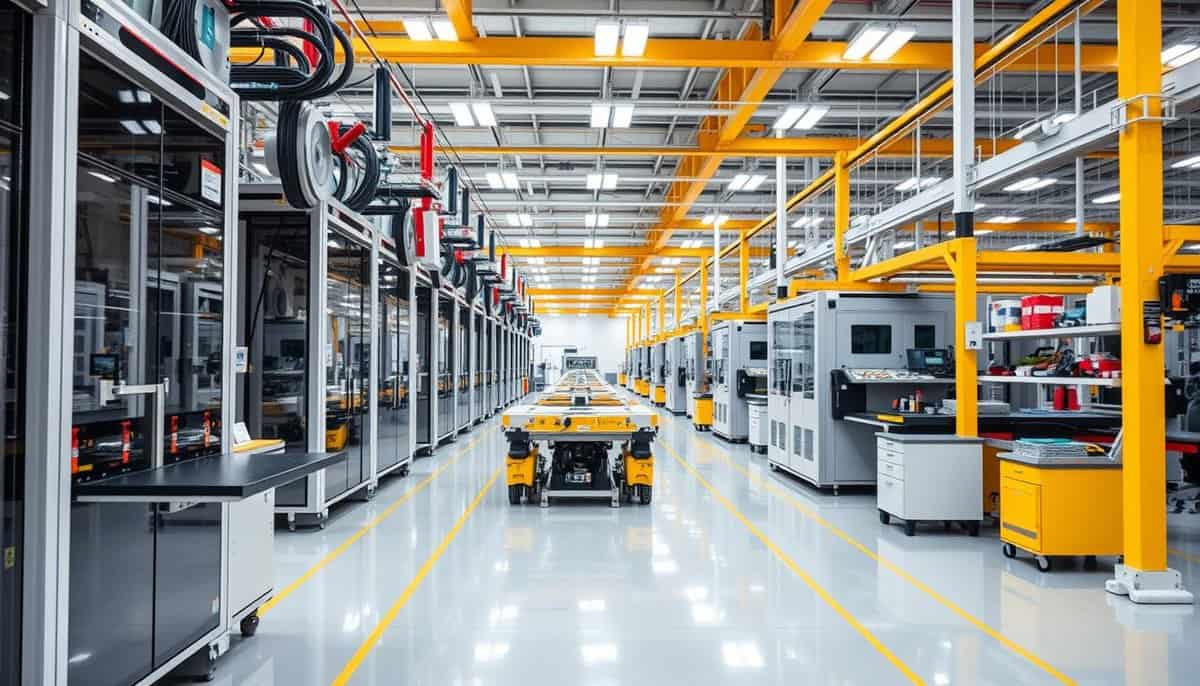





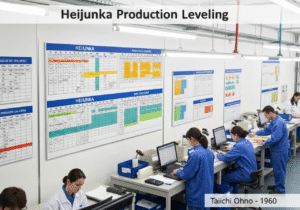
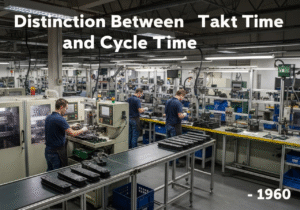
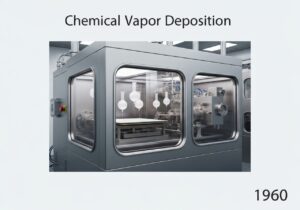



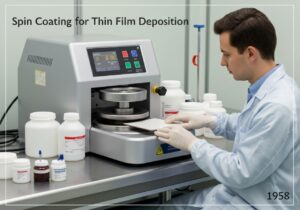


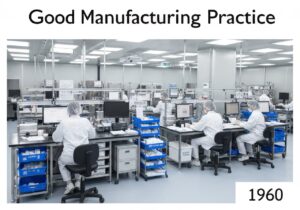










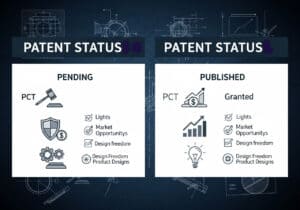
Interessante Lektüre! Ist noch jemand der Meinung, dass SMED im Vergleich zu anderen Lean-Methoden ein wenig überbewertet wird? Was denken Sie?
Wie sieht es mit Anwendungen in aufstrebenden Branchen aus, z. B. im Bereich der erneuerbaren Energien oder bei Tech-Start-ups?
Es wäre hilfreich, mehr darüber zu erfahren, wie Unternehmen den Widerstand gegen Veränderungen überwinden können, vielleicht durch den Austausch von Best Practices oder Fallstudien, in denen wirksame Strategien des Veränderungsmanagements zu einer erfolgreichen SMED-Einführung führten.
Toller Artikel über die Vorteile von SMED! Es könnte hilfreich sein, auch zu erörtern, wie die Integration von SMED mit digitalen Tools wie IoT und Datenanalyse die Rüstzeiten weiter optimieren und die Gesamteffizienz der Fertigung steigern kann.
Interessante Lektüre! Aber gibt es nicht einen blinden Fleck, wenn man das Design für SMED optimiert, ohne die Auswirkungen auf die allgemeine Produktionsqualität zu berücksichtigen?
Absolut, SMED ist nicht der Heilige Gral. Die Qualität darf im Wettlauf um Effizienz nicht auf der Strecke bleiben!